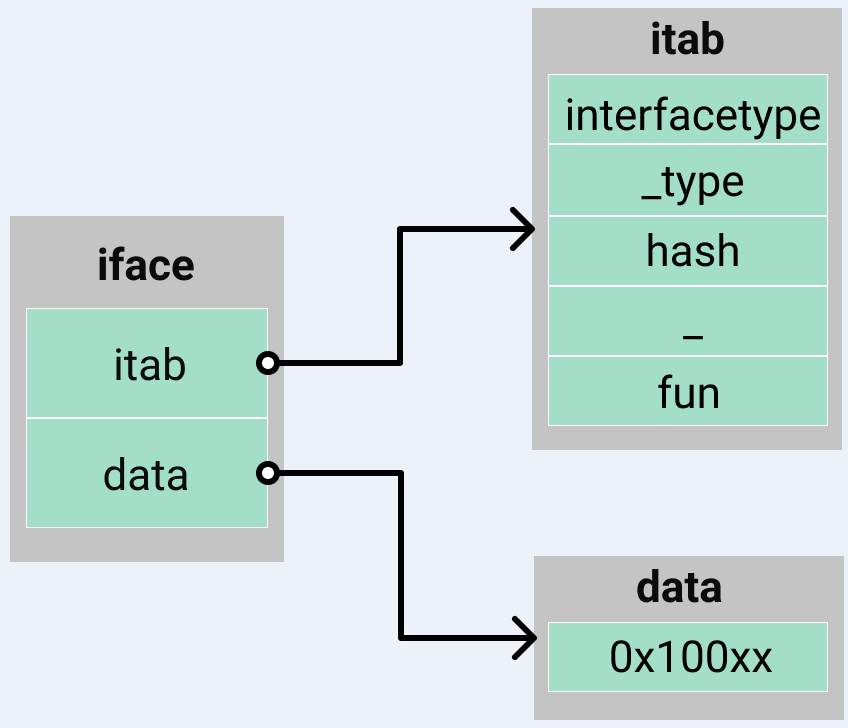interface 原理剖析 – 类型转换 #
hi, 大家好,我是 haohognfan。
可能你看过的 interface 剖析的文章比较多了,这些文章基本都是从汇编角度分析类型转换或者动态转发。不过随着 Go 版本升级,对应的 Go 汇编也发生了巨大的变化,如果单从汇编角度去分析 interface 变的非常有难度,本篇文章我会从内度分配+汇编角度切入 interface,去了解 interface 的原理。
限于篇幅 interface 有关动态转发和反射的内容,请关注后续的文章。本篇文章主要是关于类型转换,以及相关的容易出现错误的地方。


eface #
func main() {
var ti interface{}
var a int = 100
ti = a
fmt.Println(ti)
}
这段最常见的代码,现在提出一些问题:
- 如何查看 ti 是 eface 还是 iface ?
- 值 100 保存在哪里了 ?
- 如何看 ti 的真实的值的类型 ?
大部分源码分析都是从汇编入手来看的,这里也把对应的汇编贴出来
0x0040 00064 (main.go:44) MOVQ $100, (SP)
0x0048 00072 (main.go:44) CALL runtime.convT64(SB)
0x004d 00077 (main.go:44) MOVQ 8(SP), AX
0x0052 00082 (main.go:44) MOVQ AX, ""..autotmp_3+64(SP)
0x0057 00087 (main.go:44) LEAQ type.int(SB), CX
0x005e 00094 (main.go:44) MOVQ CX, "".ti+72(SP)
0x0063 00099 (main.go:44) MOVQ AX, "".ti+80(SP)
这段汇编有下面这些特点:
- CALL runtime.convT64(SB):将 100 作为 runtime.convT64 的参数,该函数申请了一段内存,将 100 放入了这段内存里
- 将类型 type.int 放入到 SP+72 的位置
- 将包含 100 的那块内存的指针,放入到 SP + 80 的位置
这段汇编从直观上来说,interface 转换成 eface 是看不出来的。这个如何观察呢?这个就需要借助 gdb 了。

再继续深究下,如何利用内存分布来验证是 eface 呢?需要另外再添加点代码。
type eface struct {
_type *_type
data unsafe.Pointer
}
type _type struct {
size uintptr
ptrdata uintptr // size of memory prefix holding all pointers
hash uint32
tflag tflag
align uint8
fieldAlign uint8
kind uint8
equal func(unsafe.Pointer, unsafe.Pointer) bool
gcdata *byte
str nameOff
ptrToThis typeOff
}
func main() {
var ti interface{}
var a int = 100
ti = a
fmt.Println("type:", *(*eface)(unsafe.Pointer(&ti))._type)
fmt.Println("data:", *(*int)((*eface)(unsafe.Pointer(&ti)).data))
fmt.Println((*eface)(unsafe.Pointer(&ti)))
}
output:
type: {8 0 4149441018 15 8 8 2 0x10032e0 0x10e6b60 959 27232}
data: 100
&{0x10ade20 0x1155bc0}
从这个结果上能够看出来
- eface.kind = 2, 对应着 runtime.kindInt
- eface.data = 100
从内存上分配上看,我们基本看出来了 eface 的内存布局及对应的最终的 eface 的类型转换结果。
iface #
package main
type Person interface {
Say() string
}
type Man struct {
}
func (m *Man) Say() string {
return "Man"
}
func main() {
var p Person
m := &Man{}
p = m
println(p.Say())
}
iface 我们也看下汇编:
0x0029 00041 (main.go:24) LEAQ runtime.zerobase(SB), AX
0x0030 00048 (main.go:24) MOVQ AX, ""..autotmp_6+48(SP)
0x0035 00053 (main.go:24) MOVQ AX, "".m+32(SP)
0x003a 00058 (main.go:25) MOVQ AX, ""..autotmp_3+64(SP)
0x003f 00063 (main.go:25) LEAQ go.itab.*"".Man,"".Person(SB), CX
0x0046 00070 (main.go:25) MOVQ CX, "".p+72(SP)
0x004b 00075 (main.go:25) MOVQ AX, "".p+80(SP)
这段汇编上,能够看出来是有 itab 的,但是是否真的是转成了 iface,汇编上仍然反应不出来。
同样,我们继续用 gdb 查看 Person interface 确实被转换成了 iface。

关于 iface 内存布局,我们仍然加点代码来查看
type itab struct {
inter *interfacetype
_type *_type
hash uint32
_ [4]byte
fun [1]uintptr
}
type iface struct {
tab *itab
data unsafe.Pointer
}
type Person interface {
Say() string
}
type Man struct {
Name string
}
func (m *Man) Say() string {
return "Man"
}
func main() {
var p Person
m := &Man{Name: "hhf"}
p = m
println(p.Say())
fmt.Println("itab:", *(*iface)(unsafe.Pointer(&p)).tab)
fmt.Println("data:", *(*Man)((*iface)(unsafe.Pointer(&p)).data))
}
output:
Man
itab: {0x10b3ba0 0x10b1900 1224794265 [0 0 0 0] [17445152]}
data: {hhf}
关于想继续探究 eface, iface 的内存布局的同学,可以基于上面的代码,利用 unsafe 的相关函数去看对应的内存位置上的值。
类型断言 #
type Person interface {
Say() string
}
type Man struct {
Name string
}
func (m *Man) Say() string {
return "Man"
}
func main() {
var p Person
m := &Man{Name: "hhf"}
p = m
if m1, ok := p.(*Man); ok {
fmt.Println(m1.Name)
}
}
我们仅关注类型断言那块内容,贴出对应的汇编
0x0087 00135 (main.go:23) MOVQ "".p+104(SP), AX
0x008c 00140 (main.go:23) MOVQ "".p+112(SP), CX
0x0091 00145 (main.go:23) LEAQ go.itab.*"".Man,"".Person(SB), DX
0x0098 00152 (main.go:23) CMPQ DX, AX
能够看出来的是:将 iface.itab 放入了 AX,将 go.itab.*"".Man,"".Person(SB) 放入了 DX,比较两者是否相等,来判断 Person 的真实类型是否是 Man。
另外一个类型断言的方式就是 switch 了,其实两者本质上没啥区别。
坑 #
interface 最著名的坑的,应该就是下面这个了。
func main() {
var a interface{} = nil
var b *int = nil
isNil(a)
isNil(b)
}
func isNil(x interface{}) {
if x == nil {
fmt.Println("empty interface")
return
}
fmt.Println("non-empty interface")
}
output:
empty interface
non-empty interface
为什么会这样呢?这就涉及到 interface == nil 的判断方式了。一般情况只有 eface 的 type 和 data 都为 nil 时,interface == nil 才是 true。
当我们把 b 复制给 interface 时,x._type.Kind = kindPtr。虽说 x.data = nil,但是不符合 interface == nil 的判断条件了。
关于 interface 源码阅读的一点建议 #
关于 interface 源码阅读的一点建议,如果想利用汇编看源码的话,尽量选择 go1.14.x。
选择 Go 汇编来看 interface,基本上也是为了查看 interface 最终被转换成 eface 还是 iface,调用了 runtime 的哪些函数,以及对应的函数栈分布。如果 Go 版本选择的太高的话,go 汇编变化太大了,可能汇编上就看不到对应的内容了。
更多学习学习资料分享,关注公众号回复指令:
- 回复 0,获取 《Go 面经》
- 回复 1,获取 《Go 源码流程图》
